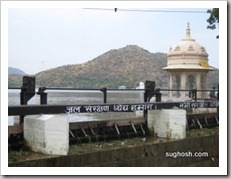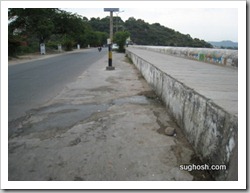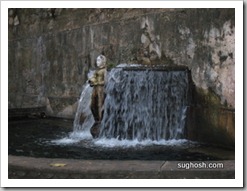 The historical lakes of Udaipur, namely Peechola – Swaroop Saagar and Fatah Saagar are more than a century old. Filling them above original design full tank level on public demand or over enthusiasm may prove to be a threat to safety. The free board above design full tank level is already less than the present design requirements and the practice of encroaching it by putting up sand bags or wooden planks for petty additional storage is already showing danger signs – there is clear and visible surface seepage over concreted surface of Fatah Saagar paal (earthen backing of Face Wall) and there is abnormal excessive seepage just downstream of Bari Paal (main Double face wall earthen dam of Peechola – Swaroop Saagar). This article deals with the hidden danger to the safety of these dams.
The historical lakes of Udaipur, namely Peechola – Swaroop Saagar and Fatah Saagar are more than a century old. Filling them above original design full tank level on public demand or over enthusiasm may prove to be a threat to safety. The free board above design full tank level is already less than the present design requirements and the practice of encroaching it by putting up sand bags or wooden planks for petty additional storage is already showing danger signs – there is clear and visible surface seepage over concreted surface of Fatah Saagar paal (earthen backing of Face Wall) and there is abnormal excessive seepage just downstream of Bari Paal (main Double face wall earthen dam of Peechola – Swaroop Saagar). This article deals with the hidden danger to the safety of these dams.
Udaipur is famous for it’s historical lakes, namely Peechola-Swaroop Saagar and Fatah Saagar. Both these lakes are quite old. As per details given in National Register of Large Dams maintained by Central Water Commission, Government of India, New Delhi, the year of construction of Peechola – Swaroop Saagar is 1795 and that of Fatah Saagar is 1889.
Dams are national property – constructed for the development of the national economy and involve large investments and other resources. Therefore, safety of all the dams is a very important aspect for safeguarding the investments and benefits derived by the nation from these dams. In addition, an unsafe dam constitutes a hazard to human life and property in the downstream reaches. Here, it is noteworthy that both these lakes are just adjoining dense populated areas of Udaipur city which have lower levels than the storage level of these lakes. Thus ensuring safety of these dams is very important.
Most of the old dams were built at a time when the technology of dam design and construction was in the stage of initial development. If these are to be reviewed as per current standards, they may not full-fill the present design criteria. Peechola -Swaroop Saagar and Fatah Saagar are no exception. For example, the present minimum free board (the margin between maximum water level of reservoir and crest of the embankment) requirement as per Bureau of Indian Standards is 1.5 meters, which not available at both these dams.
In spite of lesser free board, water is being stored above design full tank level by putting up sand bags and wooden planks for a depth of about 20 -25 centimetres at Peechola – Swaroop Saagar and Fatah Saagar for retaining petty additional storage. This year due to good rainfall, both these lakes became full and we should have felt satisfied for having full design storage and should have allowed the remaining yield to pass as overflow which goes to a series of dams like Udai Saagar, Vallabhnagar etc.
 As a result of higher water level due to this additional storage, surface seepage is visible at one or two places and saturation is visible at many places near the face wall of Fatah Saagar. The free board left is only about 0.75 meters along the main bund and is practically nil along the periphery near Moti Magri. This seepage was even more when the lake was overflowing over these wooden planks.
As a result of higher water level due to this additional storage, surface seepage is visible at one or two places and saturation is visible at many places near the face wall of Fatah Saagar. The free board left is only about 0.75 meters along the main bund and is practically nil along the periphery near Moti Magri. This seepage was even more when the lake was overflowing over these wooden planks.
 In case of Peechola – Swaroop Saagar, the main dam is a double face wall structure with earth filling in between the face walls. With great wisdom, the then builders of this dam have very wisely provided a piezometer (which can measure water pressure) type of structure attached to the down-stream face wall in the shape of a woman statue (putali) serving water through a pot. The quantity of water flowing at the structure shows the water pressure status or seepage condition of the dam body. In normal conditions, the seepage water comes out only through the pot, till the tank is not full but starts overflowing through a small semi-circular tank as soon as the lake overflows. The quantity of seepage water increases with overflow level.
In case of Peechola – Swaroop Saagar, the main dam is a double face wall structure with earth filling in between the face walls. With great wisdom, the then builders of this dam have very wisely provided a piezometer (which can measure water pressure) type of structure attached to the down-stream face wall in the shape of a woman statue (putali) serving water through a pot. The quantity of water flowing at the structure shows the water pressure status or seepage condition of the dam body. In normal conditions, the seepage water comes out only through the pot, till the tank is not full but starts overflowing through a small semi-circular tank as soon as the lake overflows. The quantity of seepage water increases with overflow level.
 At present, perhaps, due to additional storage above design full tank level, the flow at this structure is very excessive. Free falling seepage flow through the down stream face wall and surface saturation along the wall is also there. This shows that the water pressure with in the dam body is quite high. Large trees are growing at the toe or in the face wall it self. Such trees are a clear danger to the safety of dam.
At present, perhaps, due to additional storage above design full tank level, the flow at this structure is very excessive. Free falling seepage flow through the down stream face wall and surface saturation along the wall is also there. This shows that the water pressure with in the dam body is quite high. Large trees are growing at the toe or in the face wall it self. Such trees are a clear danger to the safety of dam.
 Water is oozing out just downstream of the dam in considerable quantity which can be seen in the open area of Samore Bagh situated just below the main dam (Badi Paal) of Peechola – Swaroop Saagar. Such saturated conditions of the surface strata just below the dam needs due attention, regular checks, observations and continuous watch.
Water is oozing out just downstream of the dam in considerable quantity which can be seen in the open area of Samore Bagh situated just below the main dam (Badi Paal) of Peechola – Swaroop Saagar. Such saturated conditions of the surface strata just below the dam needs due attention, regular checks, observations and continuous watch.
 Water is also coming out from the joints of pavement outside the Samore Bagh palace which shows that there is considerable water pressure below the ground level. This palace is only about 30 – 40 meters from the dam toe and thus this much water pressure, which is making way between the cemented joints of stone pavement is alarming.
Water is also coming out from the joints of pavement outside the Samore Bagh palace which shows that there is considerable water pressure below the ground level. This palace is only about 30 – 40 meters from the dam toe and thus this much water pressure, which is making way between the cemented joints of stone pavement is alarming.
 Due to natural slope towards east, total seepage of Peechola – Swaroop Saagar finally converts in to a Nallah with a discharge of about 50 – 60 litres per second which is flowing from Samore Bagh to Gulab Bagh and then to municipal drain. The daily flow is thus about 47.5 Lac litres. Thus the surface seepage in down stream of main dam of Peechola – Swaroop Saagar (Badi Paal) is considerable and needs immediate attention of the authorities concerned. This water is presently going waste through municipal drains whereas this can be very easily pumped and used for city water supply to meet partial demand and reduce the off-take from local lakes.
Due to natural slope towards east, total seepage of Peechola – Swaroop Saagar finally converts in to a Nallah with a discharge of about 50 – 60 litres per second which is flowing from Samore Bagh to Gulab Bagh and then to municipal drain. The daily flow is thus about 47.5 Lac litres. Thus the surface seepage in down stream of main dam of Peechola – Swaroop Saagar (Badi Paal) is considerable and needs immediate attention of the authorities concerned. This water is presently going waste through municipal drains whereas this can be very easily pumped and used for city water supply to meet partial demand and reduce the off-take from local lakes.
Fatah Saagar is a face wall dam with earthen backing and Peechola – Swaroop Saagar is a double face wall dam with earth filling in between. The face walls are of random rubble masonry in lime surkhi mortar. Increase in water pressure in earthen backing/filling, fully grown trees in the masonry/earth filling/near the toe of dam, visible seepage on the embankment or near the toe, etc. are clear signs of danger. The seepage force can tend to lift the soil reducing the effective weight and the soil can float out creating the conditions of "piping". Rotten roots of trees can also create paths for piping. Past experience has shown that this action of "piping" is generally slow and accumulative and the resulting failure is mostly sudden. Therefore, "we have been creating this type of additional storage in past and nothing has happened", is no excuse or reason for doing so again and again.
We can learn from the sudden failure of Jaswant Saagar dam near Jodhpur in July, 2007. This dam had a stone masonry core wall in lime surkhi mortar with earthen embankments on both sides. This dam, completed in 1899, was considered as one of very safe dams. One of the recommendations of the Enquiry Committee constituted after the failure of this dam was to make provision for an additional classification based on age of dams, (more than 100 years old) in addition to the existing classification based on height and storage capacity and to arrange detailed inspection by experts for all such dams so that appropriate remedial measures may be taken well in time. Another recommendation was to adopt a "Dam Area Plantation Manual" so that haphazard plantation in dam area can be removed/avoided.
The present situation of the main dams (Paals) of Fatah Saagar and Peechola – Swaroop Saagar calls for immediate ban on creating any additional storage above the original full tank level by sand bags or wooden planks and to take up remedial measures with out delay as suggested by experts in this field after detailed inspection, studies and investigations.
Note – This article, written in October, 2010, was first published at www.indiawaterportal.org. This year, (2011) also, the rainfall has remained above average and both the lakes have overflowed. Additional storage has not been done at Peechola – Swaroop Saagar but it has been done at Fatah Saagar. Although seepage flow is not visible on the paal surface due to extension of walk way using cement concrete, it must be there below the concrete extension. The practise of creating additional storage at Fatah Saagar also needs review considering safety factors.

The information on this site is valuable.
Many thanks for your website! I really appreciate what you’re posting here.
Thank you for having written this. I quite agree with your thoughts.
Good article! Keep it up!
Thank you for such a fantastic web site. On what other blog could anyone get this kind of information written in such an insightful way? I have a presentation that I am just now working on, and I have been looking for such info.
[url=http://acnetreatments250.blinkweb.com/]Acne medication[/url]